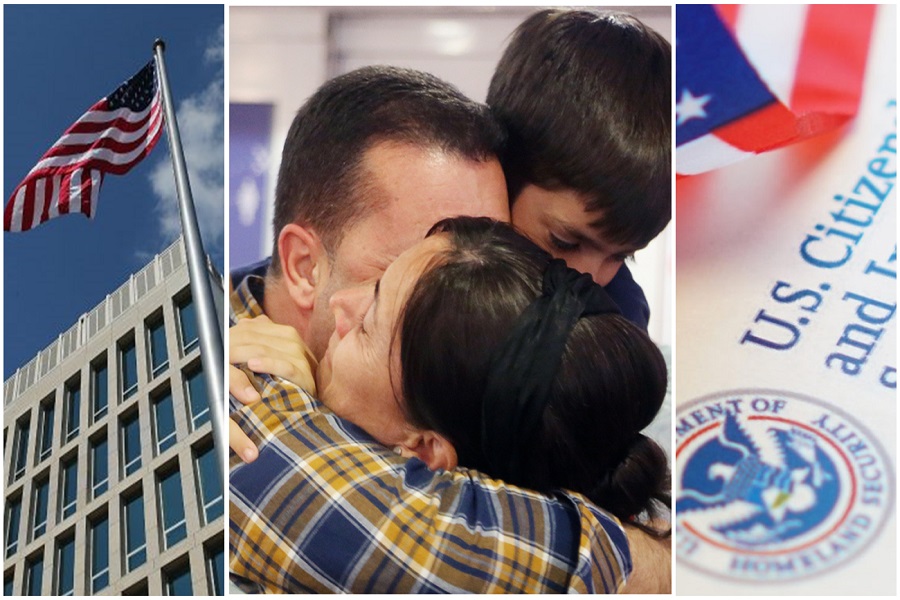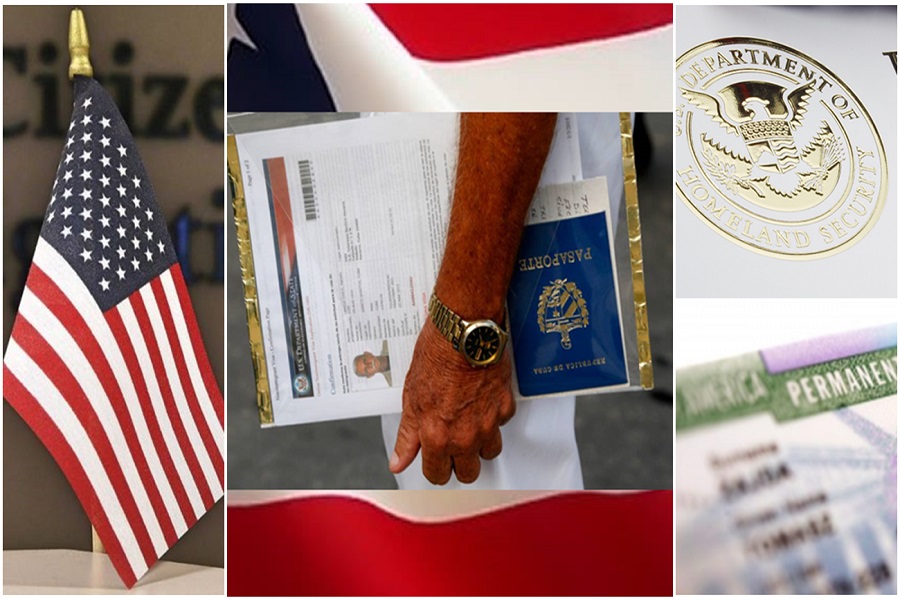In this post we will explain all the most relevant aspects about the Family Reunification Law in the United States, through which the US government favors the family integration of immigrants residing in the country.

Learn all about the Family Reunification Law in the United States
Most relevant aspects of the Family Reunification Law in the United States
The United States Family Reunification Law plan is the legal instrument through which the United States government allows family reunification of direct relatives of United States citizens or permanent residents.
These immigration laws, which regulate family reunification based on kinship, favor family members of US citizens or residents, with different treatment depending on the family bond that unites them.
The reunification process allows US citizens of foreign origin, or permanent residents (with a green card), to apply for a permanent residence visa for their immediate family members.
Preferential order for the residence visa application
Immigration officials and authorities will analyze each particular case, but the evaluation of the visa application files will be done according to the order of preference established as follows:
- First Preference (F1): For unmarried children over the age of 21 of a US citizen. Parents of an American citizen over the age of twenty-one.
- Second Preference (F2A): For the Spouse of a lawful permanent resident (with Green Card); also for unmarried children under the age of 21 of a lawful permanent resident.
- Second Preference (F2B): For the adult, unmarried children of a lawful permanent resident.
- Third Preference (F3): For married children of any age of a US citizen.
- Fourth Preference (F4): For siblings of a US citizen over the age of 21.
How does this preferential order affect the granting of the visa?
The direct relatives of immigrants already naturalized or with permanent residence (green card), that is, spouses, unmarried children and minors, and both parents, have a visa available by mandate of the Immigration Law, so the process it is slower.
This guarantees that these relatives will be able to obtain the permanent residence visa in a much shorter period of time than other relatives of the same citizens, who have to wait for one of the “available visas”.
It is evident that visa applications far exceed the number of green cards available, established annually by the United States Citizenship and Immigration Service (USCIS).
If you want more information about the Family Reunification Law in the United States, its scope and requirements, you can visit the official website of the US Citizenship and Immigration Services in Spanish.
If you find this content interesting, you may want to know what's new for hire netflix telmex? So we invite you to read this article.
Visa application procedure if the family member is outside the US territory
The United States citizen, or sponsoring permanent resident, must initiate the application procedures for a residence visa for a foreign relative before the USCIS, consigning Form I-130 together with the corresponding documentation.
Once this procedure is completed, the corresponding officials will evaluate the case presented and will grant, or deny, the visa requested by the sponsoring citizen.
Once the visa is granted, the relative holder will be able to travel to the North American territory with the granted visa, and will become a permanent resident at the time of being admitted to this country.
Visa application procedure if the relative is within the United States territory
If the family member is already within the North American territory (in a legal situation), they must process the residence visa in two steps, which we detail below:
- First step: The sponsoring family member must file Form I-130 (Visa application for an alien relative), to manage the priority date. Once the procedure has been formally admitted.
- Second step: The sponsoring citizen must file Form I-485 (application for adjustment of status), a procedure that seeks to modify the current status of the relative to become a permanent resident.
Family Reunification Law in the United States: Points to keep in mind
There are some specific cases that may affect the visa application for foreign relatives, and that the petitioners must take into consideration before starting the procedures.
- In the case of children under 21 years of age at the date of the formal start of the process, their “permanent unchanged” age for legal purposes, even if they reach the age of majority during the application process.
- If the child under the age of 21 marries during the application process, they lose their status as “under 21 years of age and unmarried”, and become a “married child of a US citizen, and the preferential treatment of the process changes immediately and must be notified to the immigration authorities of the United States.
- Fiancées of U.S. citizens or permanent residents do not directly qualify for the family reunification program, so they must apply for a K1 nonimmigrant visa with USCIS, and once approved, they will be able to travel to the United States with a ninety-day visa to marry and start the spousal resident visa application procedure.
If you find this content interesting, you may want to know what's new about the Wireless Internet Telmex? So we invite you to read this article.
Family Reunification Law in the United States: Documentation to include in the application
In order to start the resident visa application procedure for a family member, the sponsoring US citizen must submit Form I-130 (Visa application for a foreign relative), along with the following documentation:
- Copy of legal document that certifies you as a US citizen.
- Two (02) recent passport size photographs of both applicants.
- In case of being permanent residents, they must consign the document that accredits them as such.
- Proof document of the link with the foreign relative: Birth Certificate, Marriage Certificate, among others.
- Proof of legal name change, both of the American citizen or permanent resident, and of the foreign relative, if applicable (in case of marriage, for example).
- Form I-864 Affidavit of Support.
- Form I-693 Medical Report and Immunization Record.
- Police and Criminal Records, if applicable.
Family Reunification Law in the United States: Refugees and Asylees
In the event that the applicant is residing in the United States as a refugee or asylee, he must verify that the family relationship is prior to his entry into the country with this condition.
Under this condition, you can request residency for your spouse and children, father and mother, natural or adoptive, stepmother or stepfather, and submit the supporting documentation that will be requested in each case, accompanied by Form I-730.
Also, there is the possibility of bringing relatives to the United States through an Affidavit of Relationship, another program developed by the United States Citizenship and Immigration Service USCIS.
Family Reunification Program for minors from Central America
In June 2021, President Joe Biden announced the expansion of the Family Reunification Program for Minors in Central America, CAM for its acronym in English.
This program benefited qualified minors who were citizens of El Salvador, Guatemala, and Honduras, granting them refugee status and eventual permanent residence in the United States.
Secretary of State Anthony Blinken announced the second phase of this program, which will benefit a greater number of Central American minors whose parents are residing in the United States, as well as their other relatives.
“Eligibility to file a petition will now be expanded to include legal guardians, in addition to parents, who are in the United States as Lawful Permanent Residents, Temporary Protected Status, Parole, Deferred Action, Deferred Enforced Departure, or withholding of expulsion" he pointed.
Family Petition Procedures in the United States
Within the framework of the immigration policies of the United States that favor the reunification of families, US citizens of foreign origin and legal permanent residents can initiate Family Petition processes, also in the following cases:
- Both US citizens and legal permanent residents can petition for their grandchildren.
- Only US citizens can ask for their nephews.
- American citizens, over the age of twenty-one, can also petition for their siblings.
- Citizens can petition for their sons and daughters regardless of their age or marital status.
- Both citizens and residents can petition for orphans, unmarried and under the age of 21, to be adopted by them in the United States.
- Grandparents and uncles cannot be beneficiaries of these Family Petition procedures in any case.
The applicant must be, in all cases, a US citizen or legal permanent resident, have a verifiable family relationship and meet all the requirements in order to apply the Family Petition procedures.
If you are interested in learning more about the Family Reunification Law in the United States, be sure to watch the following video full of relevant information on this topic.

